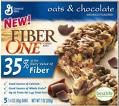April’s theme for the month is………..Fiber
This is the last week of the month……so how did you do with eating more fiber? Were you surprised at how many foods have fiber? I hope you were all successful. The last question about fiber is….. What about all the fiber bars, and high fiber cereals…what is really in them. Is that all real fiber?
When you are at the grocery store, I am sure you see a variety of new products that claim to have 9 plus grams of fiber, and all that fiber is found in a granola bar!! How can that be… you might ask??? Well there are 2 different kinds of fiber that are in foods. The fibers are called Intact Fiber, (which also contain soluble and insoluble fiber) and Isolated fiber.
Intact Fiber
Intact fiber is found in whole grains, fruits, veggies and especially in wheat bran cereals. Intact fiber are found naturally in foods. The benefit of intact fiber is that your body digests intact fiber better, and they are nutrient dense. You want to try to get 25-30 grams of intact fiber a day.
Isolated Fibers


Isolated fibers are fibers that are added to food. There has been such an increase in popularity of high fiber foods, and food companies have now added a slew of ingredients that can be counted as fiber. Among the most popular is: Inulin (also called chicory root extract), oat fiber, soy fiber, maltodextrin, starches(corn, wheat, tapioca), polydextrose, psyllium and gums (arabic, guar, and acacia). These fibers are called Isolated fibers.
Research hasn’t shown us yet what or if these isolated fibers affect your health like the intact fibers. We do know from research that the Intact fibers do lower your risk of heart disease, diabetes, and constipation. We all want that!!
Next time you are in the grocery store, reading labels and trying to decide what cereal, bread or granola to buy……use these simple guidelines.
Best Bites
1. Look for the first 2 ingredients to say “Whole.”
2. Count Bran as a good thing
3. Ignore claims like “made with whole grain,” whole grain guarantee,” or “multi-grain.” They can appear on cereals, breads, and granola bars with just a little whole grain.
4. Look for 3 gms of fiber for every 100 calories
5. Look for foods that contain no ingredients that could be counted as an isolated fiber.
I hope this month you have felt successful as you have incorporated more fiber into your diet. Try adding a little more fiber every day! Remember fiber is your friend!! Experiment in the kitchen and before you know it, healthful whole grains will become a dietary staple.















Can I ask an embarrassing question anonymously?
So…I hear fiber is your friend, but when I increase my fiber intake, even a little bit, it makes me SO SICK. I’m totally…um…regular, and if I have more fiber I feel like it messes my system up. Does it eventually get better, or does that mean that I don’t need more?
Hello Anonymous….
what a great question!! I actually get your question a lot with my clients. Fiber can change up your system….that is for sure. The first thing is to look at what kind of fiber are you getting? Is it fiber from the isolated food sources, such as fiber one bars, or fiber enhanced foods? This type of fiber can make you have GI distress(the polite way of saying diarrhea). Your body has a harder time with isolated fibers. So if you not taking in a large amount of isolated fibers…next look at how many grams of fiber you are getting a day. You want to have 25-30 grams a day, but 40grams is still okay. Especially if you are a good exerciser and drinking lots of water. Your body will adjust and going to the bathroom(#2)
Hee hee, a couple times a day is a really good thing. We all should be going at least 2 times a day or more. I find with my women clients, that taking the time to go to the bathroom just doesn’t happen.
So check and see how much fiber you are getting each day. You want 5-9 fruits and veggies a day, good whole grain breads, and always good water intake….then your bowels will thank you!!
Thanks Rachele!